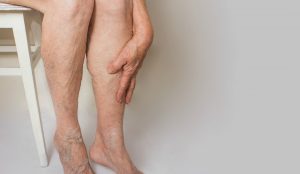Varicose veins are one of the most common conditions that can occur with age. It can be painful, unsightly and generally an unpleasant thing to live with. But what causes this condition? And is there a way you can treat it if you have it?
Types of Varicose Veins
There are actually three types of varicose veins:
- Trunk varicose veins are close to the surface of the skin and can look thick and lumpy, these are perhaps the most well-known type
- Reticular varicose veins are red in appearance and clump together
- Telangiectasia varicose veins are also known as thread or spider veins and can appear as red or blue clusters in the face and on the legs. These are harmless and do not bulge like trunk veins.
Other symptoms of these conditions can include achiness, itchiness, swelling, cramp, pain in the legs and dry, flaky skin over the surface.
Causes of the Condition
The development of varicose veins occurs when small valves within the veins – typically in the legs and feet – stop working as they should. These valves should stop the blood flowing backwards by opening and closing at the right time. But when they become faulty the blood can travel the wrong way and get trapped behind closed valves.
 Certain factors can increase your chance of developing the condition:
Certain factors can increase your chance of developing the condition:
- Genetics
- Standing for long periods e.g. at work
- Pregnancy
- Advanced age
- Being female
- Excess weight
- Previous blood clots or blood vessel abnormities
- A tumour or swelling in the pelvis.
These factors are by no means a guarantee of varicose veins occurring but there are theories behind why some of these factors make difference. In particular, why women are more susceptible. The hormones that are produced more abundantly in women are thought to relax the veins, increasing elasticity. This greater elasticity makes the valves less effective and the veins therefore become more prone to leaking. Additionally, these hormones can fluctuate during menopause or pregnancy, hence the connection to other factors.
Treating and Managing Varicose Veins
Since varicose veins is not considered a serious condition many people can continue as normal without treatment and instead do small things to help manage the severity. This can include using compression socks for up to six months, elevating the legs above the heart when resting, and getting exercise regularly to improve circulation of the blood.
However, in cases where the condition is persistent and impacts quality of life there are medical treatments available to help. These can include; endothermal ablation where heat seals affected veins, sclerotherapy where special foam closes the veins, and ligation and stripping where affected veins are removed. All of these treatments are available on the NHS, but cosmetic surgeries are not. If you feel you may need one of these treatments for your varicose veins consult your GP.

Recent Comments